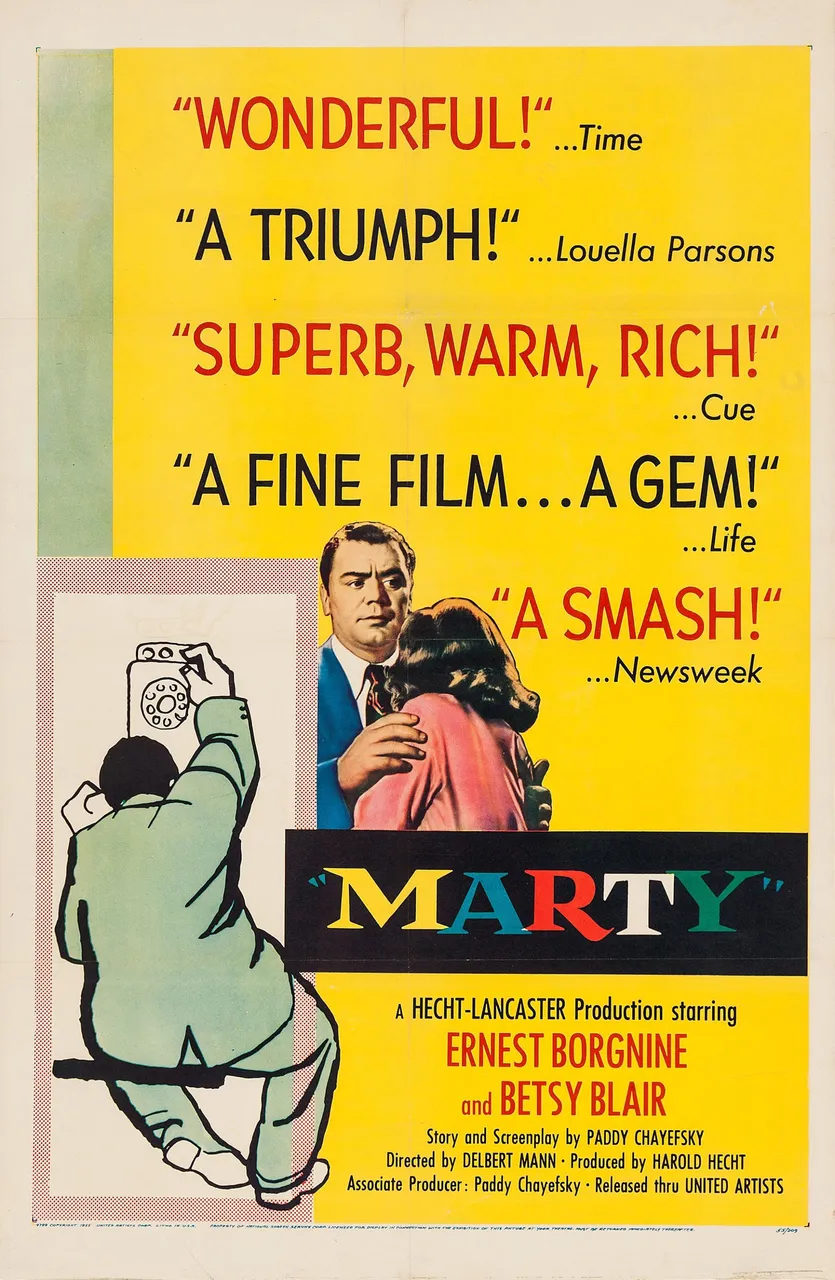
Marty is a 1955 American romantic drama film directed by Delbert Mann in his directorial debut. The screenplay was written by Paddy Chayefsky, who also wrote the 1953 teleplay of the same name, which was broadcast on The Philco-Goodyear Television Playhouse and starred Rod Steiger in the title role.
The film stars Ernest Borgnine, who won the Best Actor Oscar for his performance, and Betsy Blair. The story follows the life of Marty Piletti (Ernest Borgnine), a middle-aged butcher who has given up on the idea of love. He meets a school teacher named Clara (Betsy Blair) at a dance and falls for her, despite the opposition of his friends and family.
The film received overwhelmingly positive reviews from critics, with Ronald Holloway of Variety writing, "If Marty is an example of the type of material that can be gleaned, then studio story editors better spend more time at home looking at the television". Time described the film as "wonderful". The film won the Academy Award for Best Picture and was a commercial success, becoming the fourth highest-grossing film of 1955.
Plot
Marty is a romantic drama film that follows the life of Marty Piletti (Ernest Borgnine), a middle-aged butcher who has given up on the idea of love. He lives with his mother and is often discouraged by his friends and family about his dating life. The plot unfolds as Marty meets a school teacher named Clara Snyder (played by Betsy Blair) at a dance and falls for her.
Here are the key events in the plot:
- Meeting Clara: Marty reluctantly attends a dance and meets Clara, a school teacher who shares his feelings of loneliness and discouragement about love.
- Falling in love: Despite the opposition of his friends and family, Marty and Clara fall for each other, providing a glimmer of hope for a future together.
- Family and friends: Marty's relatives discourage him from pursuing the relationship with Clara, forcing him to choose between his family's approval or a shot at finding romance.
- Decision: Marty decides to take a chance on love and pursues Clara, despite the objections of his family and friends.
The film explores themes of loneliness, disillusionment, and the power of love to overcome these challenges. It showcases strong performances from Ernest Borgnine and Betsy Blair, making it a heartwarming and memorable story.
Trailer
https://inleo.io/threads/view/taskmaster4450le/re-leothreads-2xwhvvuvq
Cast
- Ernest Borgnine as Marty Piletti
- Betsy Blair as Clara Snyder
- Esther Minciotti as Mrs. Piletti
- Joe Mantell as Angie
- Augusta Ciolli as Aunt Catherine
Director: Delbert Mann
Writer: Paddy Chayefsky
Box office gross: The film had a budget of $343,000 and generated revenues of $3 million in the US, making it a box-office success.
Distributor: United Artists
Genre: Romantic drama
Release dates:
Production date: Began on September 7, 1954, in the Bronx.
Premiere date: March 1955.
Theatrical release date: April 11, 1955.
Streaming release date: September 16, 2008.
Themes & Reception
The film Marty is known for its themes of loneliness, the search for love, and the challenges of pursuing personal happiness in the face of societal and familial pressures. The film received critical acclaim and was a commercial success, winning the Academy Award for Best Picture and earning positive reviews for its heartfelt portrayal of the characters and their struggles.
Challenges Faced
The film faced challenges related to its low budget and the initial reluctance of major studios to produce it. Marty was an independent film with a modest budget of $343,000. The film's success ultimately defied expectations, as it grossed over $3 million, making it a surprise commercial hit.
Visual Styles & Techniques
Marty is known for its naturalistic and intimate visual style, which complements the heartfelt and realistic portrayal of the characters and their everyday lives. The film's director, Delbert Mann, employed a straightforward and unembellished approach, focusing on the emotional depth of the characters and their interactions.
Setting
Marty is set in the year 1955, primarily in the borough of The Bronx in New York City. The film utilizes many aspects of the borough, including locations such as Grand Concourse, Arthur Avenue, Gun Hill Road, White Plains Road, and several Bronx subway and elevated train lines, including the Concourse, Third Avenue, White Plains Road, and Jerome Avenue lines.
Trivia
- The character of Leo, who appears in the back of the car when Marty is approached by his friends to make up the pair for the "odd squirrel" they have with them, was played by Paddy Chayefsky, the film's screenwriter.
- Chayefsky was recruited for the role solely to save the time and money of hiring an extra. For his three lines, he was required to rejoin the actor's union, which required dues of $140.
- Marty was the first film produced by Hecht-Lancaster Productions that did not star Burt Lancaster.
- Despite its serious themes, Marty contains moments of humor, striking a delicate balance between drama and comedy.
- The film's success at the Academy Awards and at the box office paved the way for independent films to receive greater recognition and distribution.
Fun Fact
A fun fact about Marty is that despite its serious themes, the film contains moments of humor, striking a delicate balance between drama and comedy. This injection of humor provides relief from the heavier emotional moments, creating a beautifully nuanced viewing experience.
General:
Page by @iskafan